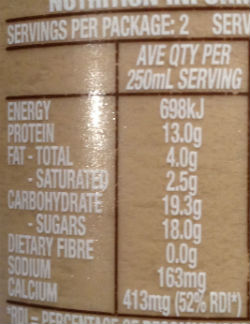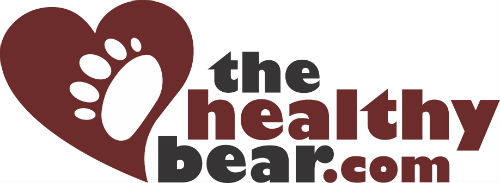Hey there Guys,
Just this week I was at the shop and was excited to see that one of my favorite brands of iced coffee had come out in a “no added sugar” version.
I was excited as I love iced coffee and am doing my best to limit sugars…in my mind I was thinking that the product would contain only a tiny amount of sugar.
 So being the health conscious consumer I that am, I bought the no added sugar version assuming that I was making a healthier choice. I was actually surprised when I read the nutrition information on the bottle.
So being the health conscious consumer I that am, I bought the no added sugar version assuming that I was making a healthier choice. I was actually surprised when I read the nutrition information on the bottle.
For a no added sugar version 40g of sugar in the bottle seemed quite a bit. Compared to the “added sugar” version which contained 50g of sugar it seemed a little odd. Also of note was that despite there being no added sugar, “natural sweeteners 957 and 960” were also added. The regular version was just milk, sugar and coffee. Only 10g more but at least I understood what the hell was in it!
Yes indeed I’d fallen for the old bait and switch…
Today I thought it was important to highlight a couple of popular advertising mechanisms that can be used to increase sales and manipulate the minds of consumers to increase beliefs of health which may not necessarily be the case.
No Added Sugar
Honest and straight forward, the company didn’t lie; they didn’t add any sugar. The other ingredients, well they can contain as much sugar as they can squeeze in but based on facts, this claim is true. No sugar was added to this product. They could have also claimed “no added cocaine, asbestos or songs by ABBA” as well if they wished to continue this stream of honesty.
Sometimes our brains take short cuts. Sometimes our brains might assume that “no added sugar” equals “no sugar” or “sugar free”. This is not the case but it does not stop us from falling prey to this bait and switch.
Another bait and switch is addition of other agents that are not sugar. That sweet taste you are experiencing? That’s not sugar, that’s the hyper sweet “natural sweeteners” added. This is done so people will never have to actually taste what coffee is like without sugar. While these sweeteners are considered safe and are not able to be absorbed by the body, their level of sweetness is so high that is masks all other flavours and just increases the cravings for other sweet foods that do contain sugar.
Additionally in the context of advertising, “natural” means that it’s a chemical found in nature. Again our mind conjures up the idea of plants being gently squeezed to release their “natural sweeteners” when in reality industrial solvents and crushers are frequently used to extract these elements. Certainly one step better than an “artificial flavour” but don’t fall for the trap that natural means that chemicals were not involved.
On an aside, I can highly recommend enjoying coffee without sugar. Milk is quite sweet by nature due to its lactose content and is sweet enough to remove any bitterness of the coffee.
Over a period of about one month I reduced my 2 spoons of sugar per coffee, down to one, then half then none. If you want to enjoy the full flavour of a nice coffee try to have it without the mask of sugar. I was pleasantly surprised and adding sugar to my coffee now makes it taste sickly.
Fiddling the numbers
Another common trick in the advertising game is to manipulate the numbers to make things look better than they seem.
In the case of an Ice Break™ drink it is in the size of the bottle. Every Ice Break™ comes in a 500ml bottle. The nutritional information on the bottle only gives information for half the bottle, as they have decided that a “serving size” is 250mL. This way they can essentially make the bottle look like it has half the amount of sugar as you are only “supposed to drink half”. Everyone pours out half and puts the remainder in the fridge for later right?
For this reason it’s important to learn to read these labels. Check for serving sizes and compare them to the actual volume. In this case it’s pretty straight forward, you just need to double the numbers.
You’ll also note that they have highlighted that one server of an Ice Breaks™ contain more than 51 percent of the “required daily intake” of calcium, an important element for bone strength. What they have neglected to mention is that one “serve” of an Ice Break also supplies:
- 10% of the days required energy, 20% if you dare to drink more then the serving suggestion.
- 10% of the suggested daily sugar intake
- Salt is pretty good with only 10% of the daily recommendation coming from this drink
- The drink contains no fiber which is helpful to avoid constipation and help reduce cholesterol
Perhaps I am being a bit argumentative but why have they only highlighted the good things and down played the bad?
So what does all this mean?
Guys, please by all means enjoy your food, enjoy a drink, heck even enjoy an Ice Break™. Having done the research now I am going to ditch the “no added sugar” version an go for the one with a little more sugar and no flavour enhancers.
Today’s post was not to disparage a single product. Today I wanted to highlight particular advertising ploys commonly used that exploit thought “short cuts” that might lead our minds down a path that are not based in fact. If you would like to learn more about “thought short cuts” and how advertisers expoit our minds I highly recommend checking out the book Influence by Robert Cialdini.
I encourage you to examine advertising, in particular health claims and feel confident in your ability to verify if what they are saying and what you are thinking, match.
Yours in good health.
Dr George

Leave a Reply